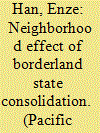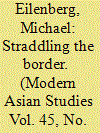| Srl | Item |
| 1 |
ID:
171024


|
|
|
|
|
| Summary/Abstract |
This article examines the process of state consolidation, or its failure, in a state’s borderland area with neighboring states in upland Southeast Asia. It proposes that we should conceptualize state consolidation as an interactive process heavily influenced by a “neighborhood effect.” It argues that we should look at how state consolidation in one country’s borderland area can be influenced by the same process in the neighboring states. In particular, the article probes under what conditions the neighborhood effect of state consolidation might take place. It argues that the effect is more profound in situations where there is power asymmetry between neighboring states, and the extent of such effect is further conditioned upon the nature of relations among these states. Empirically, this article uses a set of comparative case studies Myanmar’s modern history of state consolidation in its borderland area to illustrate the proposed theoretical framework. Differentiating between the country’s eastern borders with China and Thailand vs. its western borders with Bangladesh and India, the article empirically examines Myanmar’s state consolidation processes to illustrate the theoretical framework, focusing on variations of power balance and nature of relations between the country and its neighbors since the end of World War II.
|
|
|
|
|
|
|
|
|
|
|
|
|
|
|
|
| 2 |
ID:
108398


|
|
|
|
|
| Publication |
2011.
|
| Summary/Abstract |
Post-independence ethnic minorities inhabiting the Southeast Asian borderlands were willingly or unwillingly pulled into the macro politics of territoriality and state formation. The rugged and hilly borderlands delimiting the new nation-states became battlefronts of state-making and spaces of confrontation between divergent political ideologies. In the majority of the Southeast Asian borderlands, this implied violent disruption in the lives of local borderlanders that came to affect their relationship to their nation-state. A case in point is the ethnic Iban population living along the international border between the Indonesian province of West Kalimantan and the Malaysian state of Sarawak on the island of Borneo. Based on local narratives, the aim of this paper is to unravel the little known history of how the Iban segment of the border population in West Kalimantan became entangled in the highly militarized international disputes with neighbouring Malaysia in the early 1960s, and in subsequent military co-operative 'anti-communist' 'counter-insurgency' efforts by the two states in the late 1960-1970s. This paper brings together facets of national belonging and citizenship within a borderland context with the aim of understanding the historical incentives behind the often ambivalent, shifting and unruly relationship between marginal citizens like the Iban borderlanders and their nation-state.
|
|
|
|
|
|
|
|
|
|
|
|
|
|
|
|